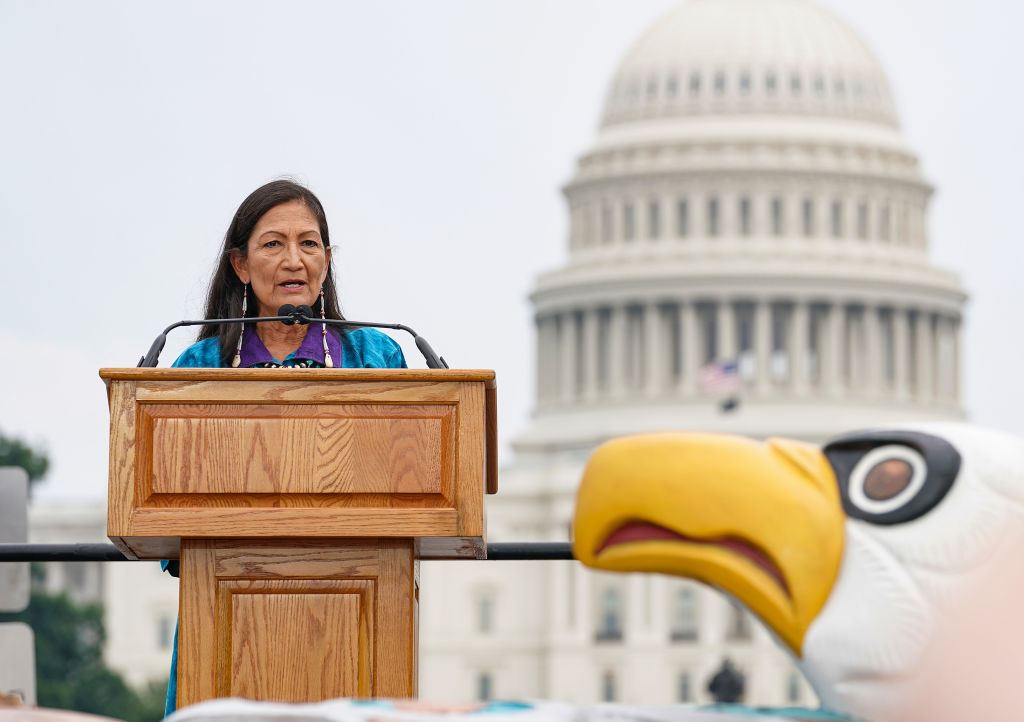Interior Secretary Deb Haaland has traveled across the U.S. to hear the stories of Indigenous survivors of the federal Indian boarding school system and connect communities with support.

A version of this article first appeared in the Daily Hampshire Gazette.
“They stripped me down, they cut my hair off, they poured the liquid in my hair and told me to go to the showers,” testified 72-year-old Dora Brought Plenty about when she first entered the Indian boarding school where she spent her childhood years.
Holding back tears, Brought Plenty—of the Lakota Sioux tribe, Turtle Clan and Standing Rock Sioux tribe—stood in front of a group of Indigenous activists in Anadarko, Okla., last July. The group included the U.S. Department of the Interior Secretary Deb Haaland, a member of New Mexico’s Laguna Pueblo. As the first Indigenous interior secretary, Haaland is taking on the devastating legacy of Indian boarding schools.
The U.S. government’s boarding schools enacted cultural genocide that created multigenerational trauma.
In June 2021, Secretary Haaland announced the formation of a Federal Indian Boarding School Initiative to recover the history and address the harms of the U.S. government’s policy of taking Indigenous children from their families and communities and relocating them to distant residential facilities where they were subject to neglect and physical, sexual, psychological and spiritual abuse. The adults in charge prohibited the children from speaking their languages, dressing in their traditional clothing and practicing their religions. They were forced into manual labor, without pay, and experienced severe malnourishment. Many children died or went missing. The U.S. government’s boarding schools enacted cultural genocide that created multigenerational trauma.
For the last two years, Haaland has traveled across the country on a “Road to Healing” tour to hear the stories of Indigenous survivors of the federal Indian boarding school system and connect communities with trauma-informed support.
Dora Brought Plenty spoke at the first stop on Secretary Haaland’s tour, which was held in Oklahoma in recognition of the state’s history as being home to 76 Indian boarding schools, the largest concentration of boarding schools in the country.
“It is crucial that the truth is known about what happened to us and what we went through at these institutes that were set up by the federal government, which have hurt survivors indefinitely and have taken thousands of lives,” said Brought Plenty, detailing the layers of abuse she endured as a child in an Indian boarding school.
Another survivor, Donald Niconie of the Kiowa tribe, described his time at a boarding school as “12 years of hell.”
Deborah McIntosh Sunagoowie spoke about losing part of her Cherokee culture in boarding schools.
“I was raised with Cherokee grandparents,” said Sunagoowie. “They read [Cherokee], spoke it. We weren’t allowed. So, here I am—I’m a full-blood Cherokee, yet I can barely understand [the language].”
The National Native American Boarding School Healing Coalition describes the Indian boarding schools as “tools of colonization, assimilation and genocide, resulting in the loss of land, language, culture, traditional foods and the permanent separation of children from their families.”
During the peak of the boarding school era from the late 19th century to 1934, 90 million acres of land passed out of Indian ownership to the United States, which Ojibwe historian Brenda Child calls “one of the largest land dispossessions in the history of the world.” Removing Indigenous children from the land was a critical element of the strategy to take ownership of Indigenous lands.
After an extensive investigation, the Interior Department released a report in May 2022 with the first-ever list of federally operated Indian boarding school sites and associated marked and unmarked burial sites. The investigation found that from 1819 to 1969, the federal government operated or supported 408 boarding schools across 37 states and territories. The department has identified marked and unmarked burial sites at approximately 53 different schools across the system. The report has maps with the general locations of schools in current states and profiles of each school.
To document the experiences of the generations of Indigenous people who attended the federal boarding school system, Haaland launched an oral history project in September to gather first-person survivor narratives. The National Endowment for the Humanities is supporting the project with a $4 million grant. The National Native American Boarding School Healing Coalition (NABS) is conducting video interviews with Indian boarding school survivors across the United States.
“This historic project will allow us to continue our work in seeking truth and justice, ensuring survivor’s stories are never forgotten, and bringing healing to future generations,” said NABS CEO Deborah Parker (Tulalip).
NABS is also supporting federal legislation (H.R. 5444/S. 1723) to create a U.S. Truth and Healing Commission on Indian Boarding School Policies, which would investigate non-federal boarding schools, including those run by religious organizations that operated over 100 boarding schools. The commission would develop recommendations for legislative and administration actions to address the ongoing impacts of Indian boarding schools.
“I know that this process will be long and difficult,” said Haaland. “I know that this process will be painful. It won’t undo the heartbreak and loss we feel. But only by acknowledging the past can we work toward a future that we’re all proud to embrace.”
To support the legislation to create the U.S. Truth & Healing Commission, go to NABS’ advocacy toolkit for fact sheets, social media resources and information about how to contact your members of Congress.
Up next:
U.S. democracy is at a dangerous inflection point—from the demise of abortion rights, to a lack of pay equity and parental leave, to skyrocketing maternal mortality, and attacks on trans health. Left unchecked, these crises will lead to wider gaps in political participation and representation. For 50 years, Ms. has been forging feminist journalism—reporting, rebelling and truth-telling from the front-lines, championing the Equal Rights Amendment, and centering the stories of those most impacted. With all that’s at stake for equality, we are redoubling our commitment for the next 50 years. In turn, we need your help, Support Ms. today with a donation—any amount that is meaningful to you. For as little as $5 each month, you’ll receive the print magazine along with our e-newsletters, action alerts, and invitations to Ms. Studios events and podcasts. We are grateful for your loyalty and ferocity.





